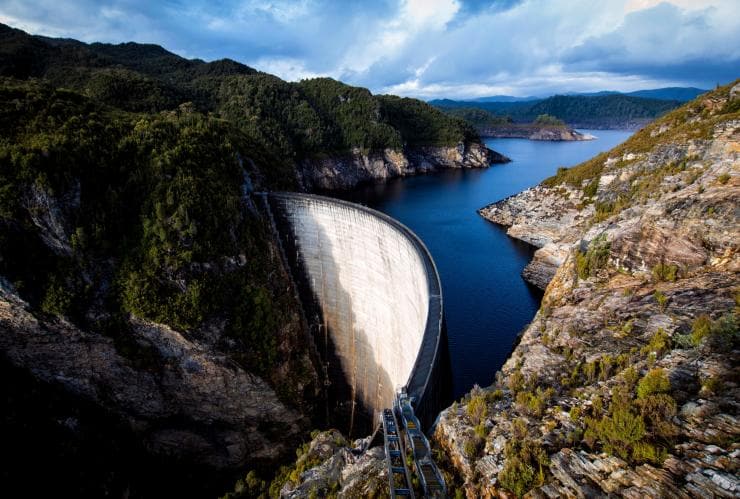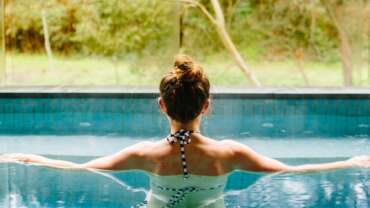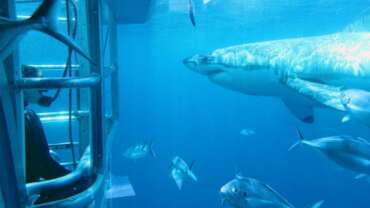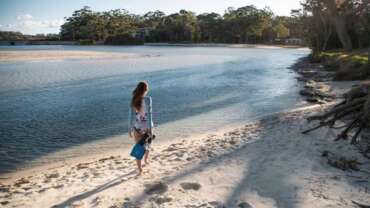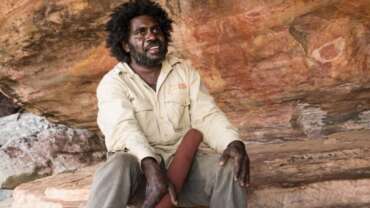Adventure and Sports Tourism in Australia
From weekend hikes to a jam-packed sporting calendar, adventure and sports play a huge role in the Australian way of life.
Get your thrills diving or snorkelling on the Great Barrier Reef or white water rafting down Tasmania’s Franklin River. Australia is a mecca for surfers, and we’ll tell you where first-class waves crash across the country, from Western Australia’s Margaret River to Bells Beach on the Great Ocean Road. Sports fans will find everything from cricket matches to camel races to get their heart pumping. Whether you like to cycle through the countryside or cheer along at world-class sporting events, you’ll find all the sports and adventure you need in Australia.
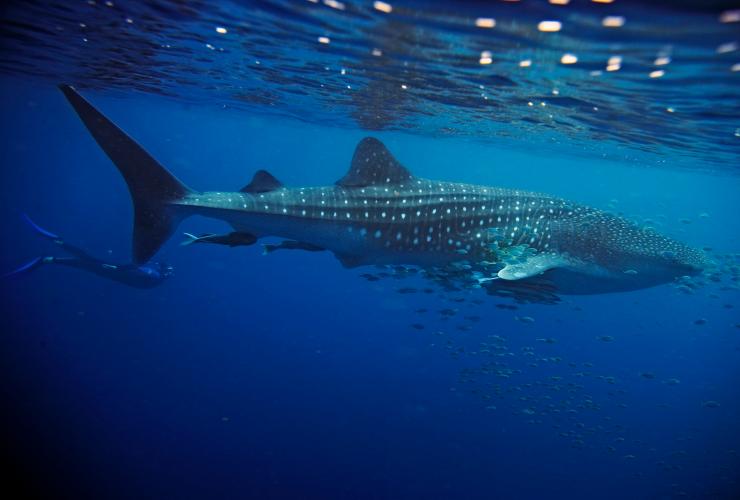
7 adrenaline rushes found only in Australia
Pump up the adrenaline on your Australian holiday with these exciting adventures.
Australia is an adventure playground, with more ways to get your heart racing than just about anywhere else. Whether you like your thrills sky high or wet and wild, Australia offers awesome adrenaline-inducing activities to suit every kind of thrillseeker.
Climb the Sydney Harbour Bridge
Where: Sydney, New South Wales
It’s a long way down from the top of the Sydney Harbour Bridge, but the view of the sparkling harbour and glittering city is unbeatable. It’s no wonder that climbing the arch of Sydney’s iconic bridge is known as a must-do.
Before you go, BridgeClimb will get you kitted out with a climbing suit and a harness that is linked to a secure, static line. It’s an easy walk, but has lots of steps. Sunrise, daytime, sunset and night-time climbs are available, as well as climbs that go just halfway if you’re nervous about heights.
Climbs can take anywhere from 1.5 to 3.5 hours depending on the type of experience you choose, so give yourself plenty of time.
Do the world’s highest dam abseil
Where: Gordon Dam, Tasmania
If getting ready to step into the void on the world’s highest commercial abseil doesn’t get the adrenaline pumping, nothing will. The Gordon Dam in south-west Tasmania, about 2.5 hours from Hobart, is several metres higher than the Sydney Harbour Bridge, and an abseiling adventure will have you descending 140 metres (459 feet) in one continuous drop.
This is an extreme adventure that’s not for the faint-hearted, but if you’re game, it’s a thrill that you’ll find only in Australia. Tours are run from Hobart by Aardvark Adventures.
Swim with whale sharks
Where: Ningaloo Reef, Western Australia
Nothing is guaranteed to make you feel small like swimming with a 14-metre (46-foot) long, 15-tonne (16.5-ton) whale shark. But don’t be put off by the name. These massive fish are truly the gentle giants of the deep. Located in the north-west corner of the country near Exmouth, Ningaloo Reef is the only place in the world where whale sharks are known to visit so close to the coast each year.
The best time to visit is between late April and early July when dozens of whale sharks swim close to the surface. Choose from snorkelling alongside these majestic creatures, or going deeper with a scuba dive adventure. Either way, it’s a wildlife encounter you’ll never forget.
You can reach Exmouth on an epic road trip along the Coral Coast, or fly to Learmonth Airport.
Dive with great white sharks
Where: Port Lincoln, South Australia
Coming face to face with a great white shark is an incomparable adrenaline rush. In the waters off the southern tip of South Australia’s Eyre Peninsula, you can climb into a cage where nothing stands between you and a great white but steel mesh. You’ll be suspended just below the surface, breathing through a ‘hookah’ as you scan the ocean for the first glimpses of a shark – sometimes almost six metres (19.5 feet) long.
Plan a road trip to Port Lincoln and book a cage diving tour with Adventure Bay Charters or Calypso Star Charters.
Raft through an ancient rainforest
Where: Franklin, Tasmania
Rafting the Franklin, one of the world’s last untamed rivers, is a magnificent wilderness adventure. Your rafting ride will begin in tranquil gorges and Tasmanian rainforest, but don’t let this fool you. Soon you’ll be navigating exhilarating rapids and splashing over river drops.
Rafting season runs from November through March, and most trips take between five and ten days. Numerous rafting companies specialise in Franklin River expeditions and depart from Hobart and Launceston.
Walk through the sky
Where: Gold Coast, Queensland
The Gold Coast is famous for its high rise towers, and you’ll get a great view of them from the top of the beachside strip’s tallest building. Even better, you won’t be on the inside of the building, but the outside.
At 270 metres (886 feet) high, the SkyPoint Climb to the summit of the Q1 Resort building is the ultimate high-altitude adventure. It’s the highest external building climb in Australia. Attached to a safety harness, you step outside onto the launch platform on level 77 (240 metres, or 787 feet high) then climb to the top of the spire. If the stairs don’t take your breath away, the view certainly will.
Valley of the Giants Tree Top Walk
Where: Denmark, Western Australia
The trees of southern Western Australia are among the tallest in the world, soaring up to 75 metres (246 feet) high. In Denmark, about 4.5 hours from Perth, you can get a view from the very top.
The Tree Top Walk is a 420-metre (459-yard) long steel truss walkway that takes you up into the treetop canopy for views that will take your breath away. Looking down from the walkway’s highest point – 40 metres (132 feet) above the ground – you’ll see why they call this place the Valley of the Giants.
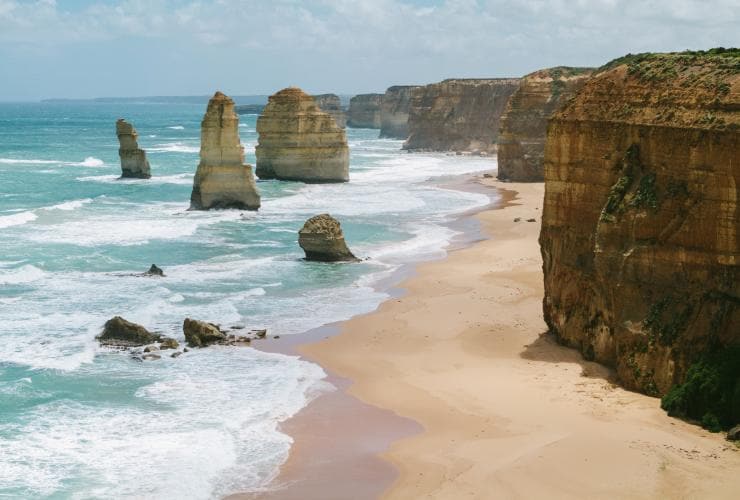
20 must-do activities in Australia
These incredible activities could all be highlights of your trip to Australia. How will you choose which ones to do?
Cruise the remote coastline of the Kimberley region, sample produce in one of the world’s most famous wine regions, or take a road trip along the Great Ocean Road. These experiences will be sure to take your breath away.
Island hop on your own private yacht (it’s affordable!)
The Whitsunday Islands offer some of the world’s finest sailing, with mostly perfect winds, calm seas, beautiful scenery and 74 islands to hop through (69 of which are uninhabited). It’s called bareboating: hiring a boat, stocking it with provisions and friends and sailing off into the sunset. Even if you have no sailing experience, companies such as Cumberland Charter Yachts will give you a yacht and a safety briefing and then set you free, with the requirement that you respond to their twice-daily radio schedule to say where you are and where you’re going. Leave from the coastal town of Airlie Beach or have your vessel delivered to Hayman or Hamilton Island.
Ride a luxury train across the continent
Named after the Afghan camel drivers that used to roam Australia’s centre, this unforgettable train journey takes in 2979 kilometres (1851 miles) of tropics, the mountains of the Flinders Ranges, scorched desert, Katherine Gorge and the Red Centre. The Ghan takes three days to cross the continent, from Darwin to Adelaide or vice versa, including fascinating whistlestop tours in Katherine and Alice Springs. You can also opt for a trip on the Indian Pacific, a four-day journey from Sydney to Perth or vice versa.
Enter another world at the Pinnacles
On the Turquoise Coast of Western Australia, 250 kilometres (155 miles) north of Perth, you will find the Pinnacles Desert, where hundreds of ancient limestone pillars look like extraterrestrial tombstones. The park is fringed by secluded white beaches, wildflowers, unique fauna and excellent fishing. Stay in the nearby fishing village of Cervantes or journey up the Indian Ocean Drive to discover all the colourful beauty and incredible wildlife interactions along the way.
Take a foodie road trip around Tasmania
Start with a breakfast of fresh doughnuts and bagels at the Farm Gate Market in Hobart then spend a few days feasting through Tasmania. There is lots of local produce to sample, with rarely more than an hour’s drive between gourmet towns and stores. Eat apples at Willie Smith’s Apple Shed, a ciderhouse turned museum in the Huon Valley; just-shucked Tassie oysters at Bangor Wine & Oyster Shed in Port Arthur; Belgian-style chocolates at the House of Anvers near Latrobe; and the triple cream brie or chilli camembert from Wicked Cheese in historic Richmond. Tasmania is famous for its cool-climate wines, and the Tamar Valley, running north from Launceston, is Tasmania’s premier wine region. Don’t miss the pinot noir, Tasmania’s signature wine variety, from the state’s oldest vineyard at Providence.
See the Sydney Harbour New Year’s Eve fireworks
One of the first places in the world to welcome the new year, Sydney Harbour puts on a spectacular show. The fireworks at 9pm and midnight on New Year’s Eve are not to be missed, with pyrotechnics from the Sydney Harbour Bridge to the Opera House, and light shows and more fireworks from barges on the harbour. There are vantage points to suit every budget. Plant a picnic rug at one of the many parks around Sydney’s foreshore, jump on a ferry or boat cruise to view from the water, book into a waterside hotel room or attend one of the many ticketed events such as the parties on Fort Denison and Shark islands or the family celebrations at Taronga Zoo Sydney and Darling Harbour.
Cruise the Kimberley
One of the best ways to see the Kimberley – one of the last true wilderness areas on Earth – is by cruise ship, and there are lots of options. You’ll get up close to the rocky shores, secluded beaches, ochre coloured gorges, lush waterfalls, and complex river systems as you enjoy gourmet meals and luxury sleeping quarters.
Ride roller coasters and water slides on the Gold Coast
For fun, not much beats the Gold Coast’s theme parks, offering huge thrilling rides, water slides and wildlife. You can bundle Dreamworld with WhiteWater World next door, or buy a combination pass for Sea World, Warner Bros Movie World and Wet’n’Wild. The ”big five” fun parks are between The Spit and Coomera, north of Surfers Paradise, where there is plenty of accommodation with excellent proximity to the Gold Coast beaches.
Dine under the stars at Uluru
In this unforgettable, intimate dining experience overlooking Uluru and the distant domes of Kata Tjuta, you’ll watch the sun set to the sound of a didgeridoo, sit on top of a dune to savour a degustation feast under the many stars (while learning all about them), then listen to Dreamtime stories by the campfire. Tali Wiru (“beautiful dune” in the local Anangu language) operates four times a week from April to mid-October, with hotel transfers from Ayers Rock Resort an hour before sunset. There are no more than 20 guests at any one time, making for an unforgettable experience.
Enjoy a gourmet feast by the beach in Margaret River
The annual Western Australia Gourmet Escape (held each November) is one of Australia’s largest food and wine festivals, celebrating the delights of Western Australia with delicious food and wine, pop-up events, cooking classes and celebrity chefs. The Margaret River region is the perfect place to experience the festivities. You’ll find wineries, restaurants and beautiful beaches to explore. From Perth, hire a car to drive three hours south to Margaret River or fly to Busselton, a town 50 kilometres (31 miles) north of Margaret River.
Dive with great white sharks in Port Lincoln
Being underwater with a great white shark (even if you are in a strengthened aluminium cage) is an adventure to tell your friends about. Calypso Star Charters and Adventure Bay Charters run one-day great white shark tours to Neptune Island, 70 kilometres (43 miles) off Port Lincoln, a 50-minute flight from Adelaide. No scuba experience is necessary (air is fed into the cage via a hose). If you’re looking for something equally as memorable but without the cage, you can also swim in open ocean with the gentle but giant whale sharks on Ningaloo Reef in Western Australia between March and August.
Stay in a unique, luxury Australian hotel
Many of Australia’s luxury lodges and resorts offer unique experiences. Longitude 131 is an intimate wilderness camp with luxury tents in the heart of Australia, where you can enjoy spectacular views and the wilderness of Uluru-Kata Tjuta National Park, bespoke safaris and gourmet meals. Emirates One&Only Wolgan Valley is a spa resort set in a conservation and wildlife reserve within the Greater Blue Mountains World Heritage Area, with private pools, wildlife tours and delicious food. Sun lovers should experience qualia, a wonderful adults-only experience on Hamilton Island. At Tasmania’s Saffire Freycinet, top-quality produce, service and coastal views are front and centre.
Watch turtles hatch in Queensland
Watching baby turtles hatch, then make their disorientated run into the sea, is a very special bucket list experience. One of the most popular places to see marine turtles nest in Australia is at Mon Repos Conservation Park, near Bundaberg in Queensland. Between November and March rangers operate nightly guided tours on the beach. Other hotspots for catching turtle nesting and hatching include the islands of Lady Elliot, Heron and Lady Musgrave. From January onwards, witness the race to the water as the hatchlings start to push their way out of their sandy nests and scurry down to the ocean – it’s quite an incredible sight.
Drive the Great Ocean Road
Hire a car in Melbourne and journey along the stunning Great Ocean Road. See the famous surf spots of Torquay and Bells Beach, the many kangaroos on the Anglesea Golf Course, the laid-back town of Lorne, and the spectacular rock formations of the 12 Apostles. Walk through waterfalls and lush forests in Otway National Park and whale watch from historic Warrnambool. You could drive it all in three hours non-stop but we recommend taking at least two days to take in the many sights.
Explore Tropical North Queensland
From Cairns up to Cape Tribulation, there’s a lot to explore in the space of just a few hours’ drive. Head out for a full-day excursion to snorkel or dive the incredible Great Barrier Reef, departing either from Cairns or the relaxed resort town of Port Douglas. Take a walk through the lush Daintree Rainforest – the world’s oldest living rainforest – with an Aboriginal guide at the Mossman Gorge Centre. Cape Tribulation is the only place in the world where two World Heritage-listed sites meet, and it also happens to be the best place in Australia to spot the elusive cassowary. Enjoy the adventures by day and indulge in a luxury eco-escape by night at Silky Oaks Lodge.
Hit the ski slopes
Australia may be best known for its beaches, reefs and outback, but it’s also home to the third longest land-based mountain range in the world. The Great Dividing Range offers up hiking trails and vistas from end to end, but towards the southern end of the range you’ll find some great places to shred an Aussie ski slope. Skiing and snowboarding in Australia is a unique experience. There aren’t many places in the world where you can find downhill ski runs lined with gum trees. Even if you don’t ski or snowboard, Australia’s snowfields have plenty of winter activities to keep you busy – from dog sledding to snow shoeing.
Visit Lord Howe Island
Hike, surf and handfeed fish as one of only 400 visitors on the World Heritage-listed Lord Howe Island, in the Pacific Ocean just a two-hour flight from Sydney. It’s one of the greenest spots in the world, with 75 per cent of the island’s original natural vegetation intact and undisturbed, leaving remarkable geology, natural beauty and coral, and a rare collection of birds, plants and marine life.
Drink in Melbourne’s laneways
There are dozens of charming small bars hidden in the many colourful laneways of Melbourne’s inner city, offering a great way to enjoy local food, drinks and people. Don’t miss a Smoky Rob Roy cocktail on the leather banquettes at the stylish, award-winning Eau de Vie. Other recommendations include Lily Blacks, Bar Americano and Shebeen. Or discover your own small bar, and start making friends with the locals.
Fly over Lake Eyre in flood
Lake Eyre contains the lowest natural point in Australia, and on the rare occasions that it fills, is the largest lake in Australia, covering 9500 kilometres (5900 miles). It can attract thousands of birds – pelicans, banded stilts, silver gulls and more – and, for a month in spring, wildflowers. Even when the lake is not full, the vastness of this park, the whiteness of the salt lake and the surrounding low red dunes of the desert seen from a scenic flight give you a true sense of the outback. Scenic flights depart from Marree, Hawker, Ceduna, Rawnsley Park, Wilpena Pound and William Creek in South Australia, and interstate.
Hot air balloon above Australia’s capital
Canberra is renowned among international balloonists as one of the best places to balloon, with calm conditions, green scenery and the view of Lake Burley Griffin mixed with interesting architecture, monuments and sculptures, as well as multiple take-off and landing areas. Afterwards, you can celebrate with a champagne breakfast at the Park Hyatt Hotel.
White water raft the Franklin River
The Franklin River, on Tasmania’s wild west coast, is pure nature, yet it’s never more than 150 kilometres (93 miles) from Hobart. World Expeditions and Franklin River Rafting offer rafting trips ranging from eight to 11 days along the scenic 125 kilometres (78 miles) of the Franklin to the Gordon River, camping on the riverbanks at night.
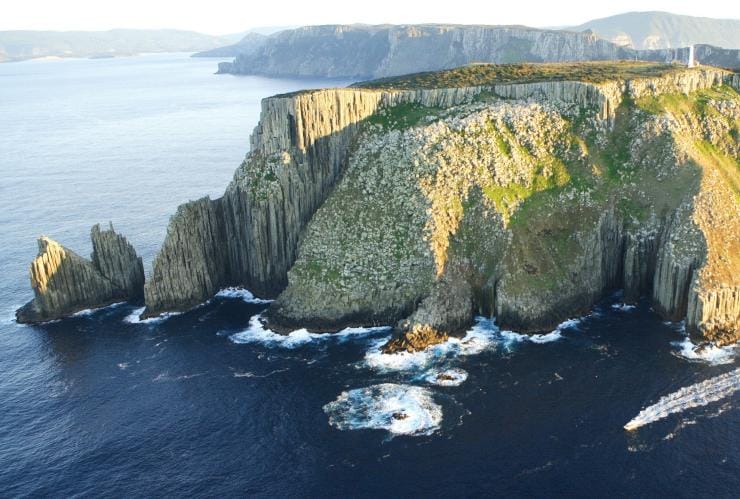
Australia’s best diving spots
Diving in Australia isn’t limited to the Great Barrier Reef – read on to discover some of the best dive spots around the country.
The Great Barrier Reef attracts divers from all over the world. It’s really no surprise – the reef is awash with vibrantly coloured corals and a spectacular selection of marine life. But did you know that Australia’s dive sites extend beyond this natural wonder of the world to nearly all of our country’s states and territories? From our spectacular coral reefs to purposely sunken ships, here are some of the best dive spots that Australia has to offer.
The best dive sites in Queensland
The Great Barrier Reef
The Great Barrier Reef is the heart and soul of diving in Australia. This 2,300-kilometre (1429-mile) stretch of interconnected reefs and islands has a huge selection of dive sites. From Cairns or Port Douglas, you can access the exclusive Outer Great Barrier Reef on a liveaboard dive boat with Pro Dive Cairns. In the Southern Great Barrier Reef, Heron Island has more than 20 nearby dive sites to choose from, all of which have an abundance of tropical fish and corals. Lady Elliot Island gives you the opportunity to swim with manta rays, and nearly all the resorts on the Whitsunday Islands will offer diving trips out to see the natural beauty of the reef. Take your pick of destination and get diving on the Great Barrier Reef.
SS Yongala Wreck
You might be surprised to know that Queensland’s coast offers more to dive enthusiasts than the reef. From Townsville, you can do an exciting dive out to the Steam Ship Yongala shipwreck, which sunk during a cyclone in 1911. The wreck, which is still mostly intact and lies 14-28 metres (46-92 feet) below the surface, wasn’t found until 1958. It’s been an attraction for divers ever since. A day trip with Yongala Dive will allow you to do two dives to explore the historic underwater remains.
Tangalooma Wrecks
The Tangalooma Wrecks are another great option for shipwreck exploration. Located just off the shore of Moreton Island, this long chain of ships were deliberately sunk in 1963 to create a safe mooring area for boats. Dive tours and equipment hire are available to book through Tangalooma Island Resort, which is only an hour away from the city of Brisbane via ferry.
The best dive sites in Western Australia
Ningaloo Reef
Australia’s second largest coral reef, Ningaloo Marine Park, sits just off the coast of Western Australia. This reef offers a unique opportunity to swim alongside whale sharks, which pass through this area between March and August each year. Daily dive tours depart from the town of Exmouth with Dive Ningaloo.
Rowley Shoals
If you’re looking for an exclusive dive experience, this is it. Rowley Shoals is a group of three ring-shaped reefs located about 300 kilometres (186 miles) off the coast of Western Australia. Divers who are keen to explore these pristine and remote reefs must take a charter cruise from Broome, which generally last between four and eight days.
Christmas Island
Christmas Island is located far off the coast of Western Australia, and while its location is remote, it actually hosts some of the most amazing dive sites in Australia. Not only is the island surrounded by coral reefs, it’s also perched near the rim of the Java Trench (the Indian Ocean’s deepest point), which means that you can take a trip out with Wet n Dry Adventures to access some of the longest drop-offs in the world just a short distance from shore.
The best dive sites in South Australia
Port Lincoln
If you’re feeling adventurous, cage diving with great white sharks is sure to get your adrenaline pumping. Port Lincoln, which is just a 50-minute flight from Adelaide, is the only place in Australia where you can have this unique dive experience. A day trip with Adventure Bay Charters will take you out to the Neptune Islands where you can see these majestic creatures up close in their natural environment. Tour operators will lure the sharks with bait or via acoustic attraction to swim around the metal cage.
Glenelg
On the outskirts of Adelaide, Glenelg offers multiple dive options for beginners to pros. For a shallow dive, you can swim out from the shore to explore the jetty which holds a variety of marine life including nudibranchs, crabs, and sea stars. For a deeper dive, head out to the Glenelg Dredge and Glenelg Barge wrecks with Adelaide Scuba, or visit the Glenelg tyre reef which was set up in 1983 as a fish breeding ground.
The best dive sites in New South Wales
Shelly Beach
This shore dive site is just a stone’s throw away from Manly – one of Sydney’s most popular beach suburbs. Shelly Beach provides a maze of boulders and sea grass to wind through, and the nearby dive site of Fairy Bower is another popular spot with frequent sightings of eels and rays. If you’re lucky, you might even spot the resident octopus or blue groper. Go out on your own, or explore the area with Dive Centre Manly.
Solitary Islands
This collection of rocky islands is located off the coast of Coffs Harbour (a short flight or just under a six-hour drive north of Sydney). There are plenty of spots to dive around here, but South Solitary Island is the most popular with nine dive sites. Some dive options include Manta Arch, where there are often more than 30 grey nurse sharks hanging around, or The Gantry, where you can seek out the wreckage of a collapsed crane that was once used to load supplies on to the island. It’s easy to get to the Solitary Islands from the coast by booking a half-day trip with Jetty Dive.
Lord Howe Island
As there are only 400 tourists allowed on Lord Howe Island at any one time, it’s nearly guaranteed that you will have the dive sites all to yourself. The jagged rocky outcrop of Balls Pyramid, accessible via boat with Pro Dive Lord Howe Island, is a popular spot for divers. Here you can explore caves lined with rocky columns and reefs that hold deep-sea species of Ballina angelfish, which are usually only found at depths of over 100 metres (328 feet).
The best dive sites in Victoria
Portsea Pier
Victoria has several piers that are great for diving, and Portsea makes a name for itself as one of the best. This jetty on the Mornington Peninsula is easy to enter from the shore or from ladders along the pier and is known for sightings of weedy seadragons and seahorses. Some other great options are Blairgowrie Pier, Rye Pier, and Flinders Pier.
Port Phillip Bay
There are plenty of interesting dive spots in Port Phillip Bay, including over 50 shipwrecks, four WWI submarines, and a 136-metre (446-foot) guided missile destroyer. Departing from Portsea or Queenscliff, Red Boats can take you out to see some of the wrecks hidden beneath the surface of the bay.
The best dive sites in Tasmania
Bicheno
With nearly 20 local dive sites, Bicheno is one of the best places to dive in Tasmania. As the waters here are temperate, the visibility may be less clear than Australia’s tropical waters, but the increased levels of plankton mean that there will be plenty of marine life around.
Tasman Peninsula
The Tasman Peninsula is known for its large colonies of fur seals. If you want to check out these playful creatures in their natural habitat, sign up for a scuba with the seals through Eaglehawk Dive. This area also has giant kelp forests, underwater caves, and deep water sponge gardens.
The best dive sites in the Northern Territory
Darwin Harbour
There are more than 90 shipwrecks scattered throughout Darwin Harbour, many of which were sunk during the WWII bombing of Darwin. Access to the wrecks can be tricky to time perfectly with tides and variations in water clarity, but when you do get the chance to head down, you can explore remnants of the Mauna Loa, the USS Peary, the Zealandia, or the Catalina 4 with Sea Darwin.
Vernon Islands
If you’ve ever wondered what it would be like to dive into an ocean sinkhole, here’s where you can try it. A two-hour boat transfer from Darwin with Sea Darwin will take you out to the Vernon Islands, where it’s possible to see sheer cliffs of coral descending into the depths, all while swimming alongside the rays and turtles that live in these sinkholes.
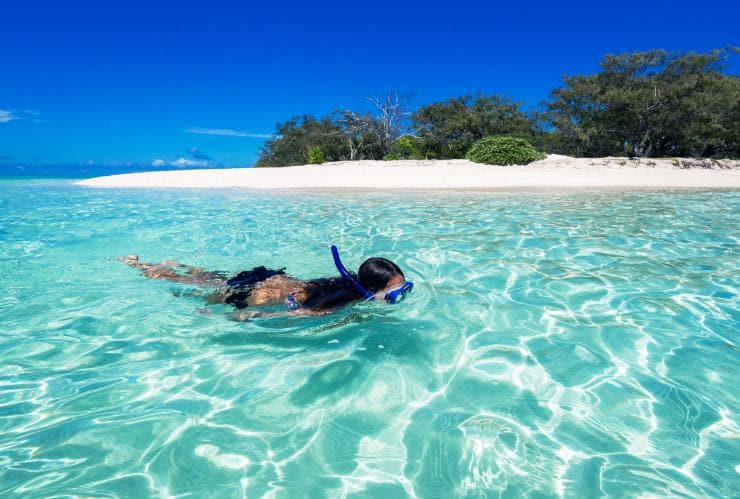
Australia’s best snorkelling spots
Just beneath the surface of Australia’s coastal waters lies a vibrant array of underwater treasures. Here’s where you can see them for yourself.
Australia’s amazing natural scenery isn’t limited to what you see above the ground – once you glance beneath the surface of our coastal waters, you’ll be treated to vibrantly coloured corals, tropical fish, massive rock formations, and historic shipwrecks. If you’re itching to take a look under the water on your trip to Australia, try jumping in to one of these incredible snorkelling spots.
The best spots to go snorkelling in Queensland
The Low Isles
The holiday town of Port Douglas in far north Queensland is one of the best places to access the Great Barrier Reef. Just 15 minutes away by boat is the Low Isles, where you can snorkel among corals beside the local population of sea turtles. You can visit the Low Isles on a day trip or even a half-day trip with Reef Sprinter if you’re short on time.
Green Island
Just a 45-minute catamaran ride from Cairns is Green Island – a 6,000-year-old coral cay that holds the Great Barrier Reef’s only rainforest, along with over 120 native plant species and colourful coral. An Ocean Free tour carries a maximum of just 25 guests and sails to an exclusive mooring. Grab your goggles to see a stunning coral garden below the surface. Nearby are unique coral cays to be discovered. Hop aboard an Ocean Freedom tour to explore Upolu Cay Reef and Outer Edge Upolu Reef. When conditions allow, natural sand banks appear above the water for the ultimate castaway experience. You can visit Green Island on a day trip, or stay overnight at Green Island Resort.
Michaelmans Cay
Just off the coast of Cairns is Michaelmas Cay, a small sand island only 360 metres (394 yards) long and 50 metres (55 yards) wide. On a day trip with Ocean Spirit Cruises, you can visit the cay to snorkel the surrounding reef (which is known for having an abundance of giant clams) and learn about the 23 species of seabirds that use the island as a habitat during migration.
Heron Island
Heron Island, which is accessible via boat transfer from Gladstone, offers something special for visitors looking for an amazing snorkelling experience. Here, you can gear up on the beach then walk straight into the ocean to spot bright blue starfish and giant sea cucumbers. There’s nothing to do but relax around here, so you can spend all day floating over the corals if you want. Just remember to come in after sunset to watch turtles nesting on the beach.
Lady Elliot Island
On the southern tip of the Great Barrier Reef lies Lady Elliot Island, accessible only by scenic flight from Brisbane, Bundaberg, Hervey Bay, or Gold Coast. The island has a world-class eco resort committed to protecting the surrounding reef environment. Manta rays are a common sight around here, so prepare to share the waters with some aquatic friends.
Moreton Island
The Tangalooma Wrecks at Moreton Island are only an hour away from the city of Brisbane via ferry. This long chain of shipwrecks were deliberately sunk in 1963 to create a safe mooring area for boats, and the wrecks are now a popular snorkelling spot for travellers. You can take a snorkelling tour through Tangalooma Island Resort, or strong swimmers can do a self-guided tour of the wrecks. If you’re lucky, you might even see some lionfish or wobbegongs in the area.
The spots to go snorkelling in New South Wales
Lord Howe Island
Snorkelling at Lord Howe Island, which is only a two-hour flight from Sydney, is a unique experience. Not only will you be one of just 400 tourists allowed on the island at any one time, you will also have your choice of snorkelling location just beyond the shore at Lagoon Beach, Ned’s Beach, Old Settlement Beach, Erscott’s Hole or Blinky Beach. Take your pick.
Julian Rocks
Julian Rocks is a popular snorkelling spot for visitors to Byron Bay, just a two-hour drive south of Brisbane. Situated within the Cape Byron Marine Park in northern New South Wales, a boat trip out with Byron Bay Dive Centre will allow you to see the clear, shallow waters around Julian Rocks, which are filled with both tropical marine life and animals from the Southern Ocean. You might even see some dolphins or whales nearby.
Shelly Beach
Just north of the Sydney Harbour Bridge lies the beachy suburb of Manly, home to the calm, clear waters of Shelly Beach. You can head out on your own, or join an EcoTreasures snorkelling tour to discover more than 200 fish species, including the famous Blue Groper.
The best spots to go snorkelling in Western Australia
Ningaloo Reef
As Australia’s second largest coral reef, Ningaloo Marine Park is the perfect place to go snorkelling. The reef stretches along 260 kilometres (162 miles) of coastline and is easiest to access from the town of Exmouth, which is just a two-hour flight north from Perth. With Ningaloo Reef Dive, you can cruise out to the reef and spot some of the 500 species of fish and wide variety of marine life that live in these waters.
Rottnest Island
The marine environment surrounding Rottnest Island includes a huge number of secluded beaches and incredible snorkelling spots. Popular spots for snorkellers include The Basin, Parakeet Bay, Parker Point, Little Salmon Bay and Little Armstrong Bay.
Busselton Jetty
A 2.5-hour drive south of Perth is the city of Busselton, which features the longest wooden pier in the Southern Hemisphere. The 1.8-kilometre (1.1-mile) long jetty is home to some brightly coloured coral and fish, so visitors can take a snorkelling tour with Dive Busselton Jetty or do a self-guided exploration of the jetty’s marine life.
The best spots to go snorkelling in South Australia
Port Noarlunga
Visitors to McLaren Vale wine region should spend a morning snorkelling in Port Noarlunga. You’ll spot a large variety of fish including zebrafish and old wives as well as sea stars. Confident swimmers can head out to explore the Port Noarlunga Reef. Built in 1994, the reef trail is part of the Port Noarlunga Reef Aquatic Reserve.
Stony Point, Eyre Peninsula
For a truly memorable experience with some of the sea’s most unusual creatures, join the Swim with the Giant Cuttlefish tour in South Australia. This two-day tour itinerary, which has departures available to book during the cuttlefish migration season in July, is packed with added benefits that include exclusive cuttlefish insights by a marine expert, sightseeing through the wilderness of the Southern Flinders Ranges and hiking along the rugged Alligator Gorge in the Mount Remarkable National Park. The tour includes return transport from Adelaide and all equipment.
Baird Bay
In the calm waters of Baird Bay, 284 kilometres (176 miles) from Port Lincoln towards Streaky Bay, Baird Bay Ocean Eco Experience will take you snorkelling with resident pods of bottlenose dolphins and inquisitive sea lions in their natural environment. Snorkelling with the sea lions takes place in a safe shallow area, while the dolphins swim in deeper ocean. Both are suitable for all levels of swimmer.
The best spots to go snorkelling in Victoria
Mornington Peninsula
Flinders Pier, located in Flinders on the southern tip of the Mornington Peninsula, is regarded as the ultimate spot to see weedy seadragons. While you’re in the water keep your eyes peeled for rays, cuttlefish, crabs and various species of fish. The pier is quite long but you’ll find plenty of ladders along its length for easy exit and entry points if you don’t wish to enter from the shore.



